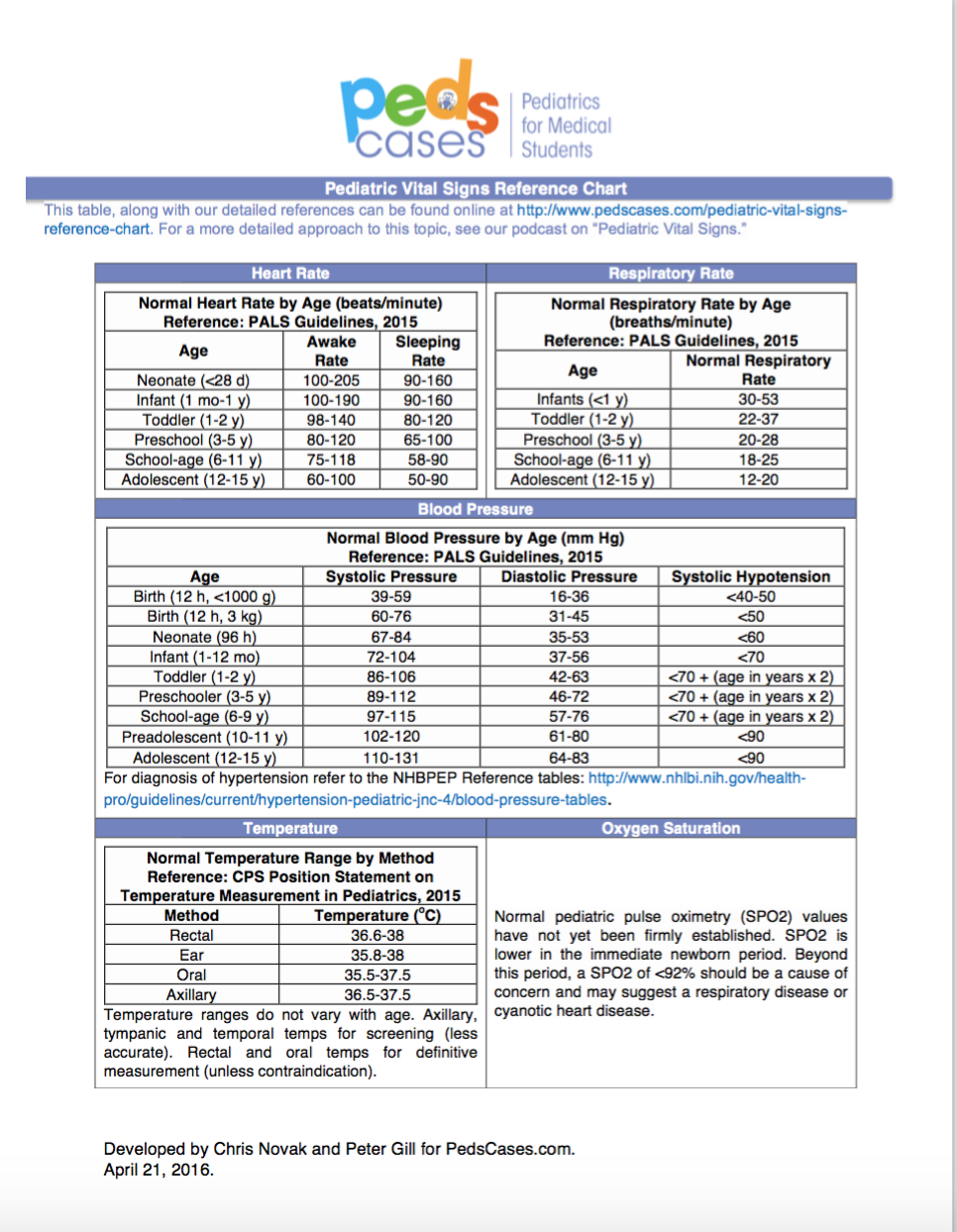For a more detailed approach to this topic, see our podcast on "Pediatric Vital Signs." Click the image for a full screen handout.
Heart Rate:
Normal Heart Rate by Age (beats/minute) Reference: PALS Guidelines, 2015 | ||
Age | Awake Rate | Sleeping Rate |
Neonate (<28 d) | 100-205 | 90-160 |
Infant (1 mo-1 y) | 100-190 | 90-160 |
Toddler (1-2 y) | 98-140 | 80-120 |
Preschool (3-5 y) | 80-120 | 65-100 |
School-age (6-11 y) | 75-118 | 58-90 |
Adolescent (12-15 y) | 60-100 | 50-90 |
Respiratory Rate:
Normal Respiratory Rate by Age (breaths/minute) Reference: PALS Guidelines, 2015 | |
Age | Normal Respiratory Rate |
Infants (<1 y) | 30-53 |
Toddler (1-2 y) | 22-37 |
Preschool (3-5 y) | 20-28 |
School-age (6-11 y) | 18-25 |
Adolescent (12-15 y) | 12-20 |
Blood Pressure:
Normal Blood Pressure by Age (mm Hg) Reference: PALS Guidelines, 2015 | |||
Age | Systolic Pressure | Diastolic Pressure | Systolic Hypotension |
Birth (12 h, <1000 g) | 39-59 | 16-36 | <40-50 |
Birth (12 h, 3 kg) | 60-76 | 31-45 | <50 |
Neonate (96 h) | 67-84 | 35-53 | <60 |
Infant (1-12 mo) | 72-104 | 37-56 | <70 |
Toddler (1-2 y) | 86-106 | 42-63 | <70 + (age in years x 2) |
Preschooler (3-5 y) | 89-112 | 46-72 | <70 + (age in years x 2) |
School-age (6-9 y) | 97-115 | 57-76 | <70 + (age in years x 2) |
Preadolescent (10-11 y) | 102-120 | 61-80 | <90 |
Adolescent (12-15 y) | 110-131 | 64-83 | <90 |
For diagnosis of hypertension refer to the NHBPEP Reference tables. You can find calculators for determining blood pressure percentiles on UpToDate or other medical apps.
Temperature:
Normal Temperature Range by Method Reference: CPS Position Statement on Temperature Measurement in Pediatrics, 2015 | |
Method | Normal Range (oC) |
Rectal | 36.6-38 |
Ear | 35.8-38 |
Oral | 35.5-37.5 |
Axillary | 36.5-37.5 |
Temperature ranges do not vary with age. Axillary, tympanic and temporal temps for screening (less accurate). Rectal and oral temps for definitive measurement (unless contraindication).
Pulse Oximetry
Normal pediatric pulse oximetry (SPO2) values have not yet been firmly established. SPO2 is lower in the immediate newborn period. Beyond this period, normal levels are stable with age. Generally, a SPO2 of <92% should be a cause of concern and may suggest a respiratory disease or cyanotic heart disease.
References
- Heart and Stroke Foundation of Canada. 2015 Handbook of Emergency Cardiovascular Care for Healthcare Providers. 2015 Nov. p. 77.
- Fleming S, Thompson M, Stevens R, Heneghan C, Pluddemann A, Maconochie I, Tarassenko L, Mant D. Normal ranges of heart rate and respiratory rate in children from birth to 18 years: a systematic review of observational studies. Lancet. 2011Mar 19;377(9770):1011-1018.
- Fouzas S, Priftis KN, Anthracopoulos MB. Pulse Oximetry in Pediatric Practice. Pediatrics. 2011 Oct 1; 128(4):740-752. Available from: http://pediatrics.aappublications.org/content/128/4/740.full
- Leduc D, Woods S. Temperature measurement in paediatrics.” Canadian Paediatrics Society Position Statement. Posted: 2000 Jan 1. Updated: 2015 Oct 15 [cited 2016 Apr 22]. Available from: http://www.cps.ca/en/documents/position/temperature-measurement
- McGee S. Evidence Based Physical Diagnosis, 3rd Edition. Saunders. 2012.
- National High Blood Pressure Education Program Working Group. Fourth Report on the Diagnosis, Evaluation, and Treatment of High Blood Pressure in Children and Adolescents. National Institute of Health. 2005. Available from: http://www.nhlbi.nih.gov/health-pro/guidelines/current/hypertension-pediatric-jnc-4/blood-pressure-tables
| Attachment | Size |
|---|---|
| 252.48 KB |
